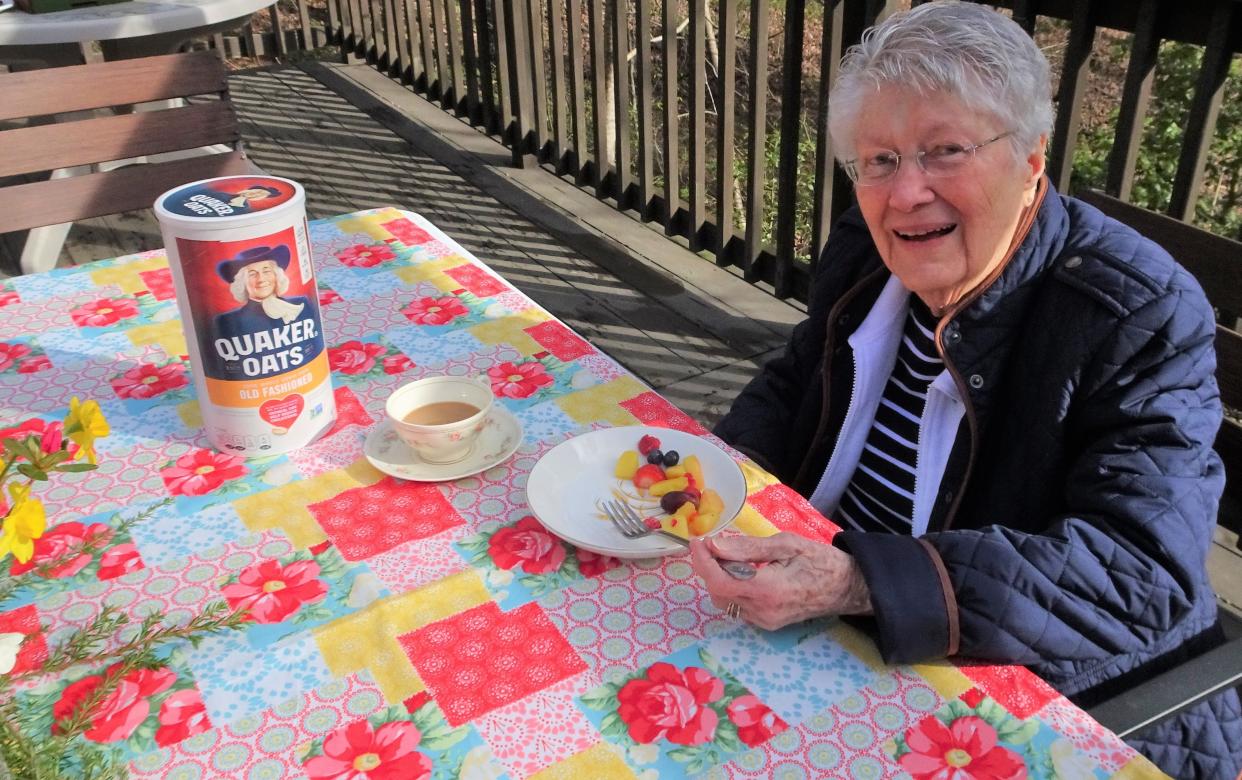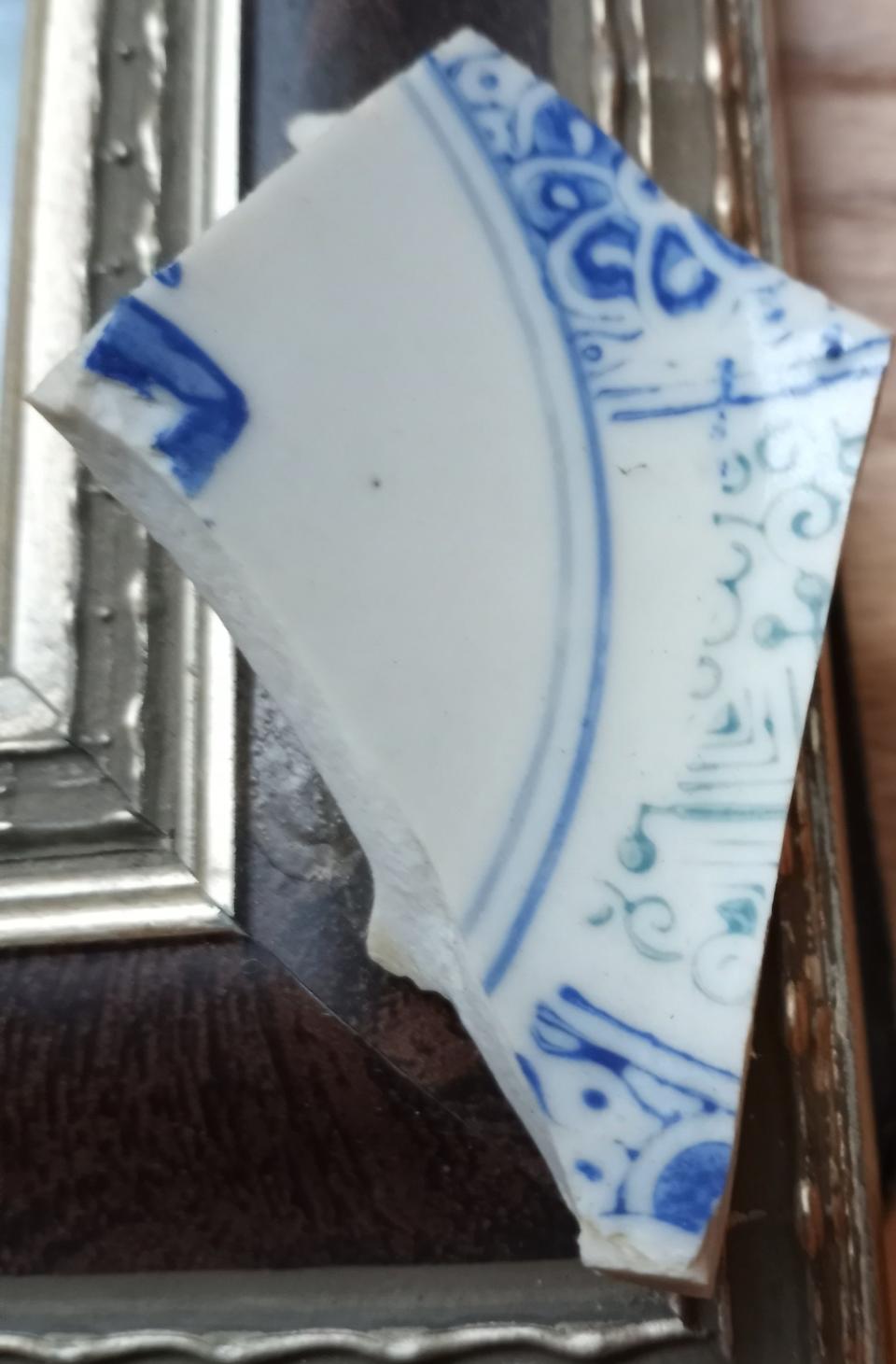Back in the day column: When glass dishes came in oatmeal boxes

Granny had a collection of dishes that came free in oatmeal boxes. It was quite exciting to open a new cylinder-shaped cardboard carton of oatmeal and see if a matching saucer was included for the teacup from the last box. Granny and I could joke that the worst outcome would be another teacup. Then we would each have a new cup.
But if this box contained a saucer, she could cool her coffee as she sipped it. Mountain people back then enjoyed scalding hot coffee, but the saucer underneath the cup wasn’t just for looks. They liked to pour coffee from the cup into the saucer to cool before they drank it.
Colorful tableware was always fun for a lady as decorative as Granny. Because of Grandpa’s railroad job, she was fortunate to have adequate dishes stacked on shelves inside the metal pie safe. It doubled as a china cabinet since she also used the wood cookstove warmer to store desserts. But she enjoyed dishes in new colors and designs to drink coffee, beautify the table, and add to her assortment.
The long-running promotional campaign by Quaker Oats actually began in the 1920s and became extremely popular during the Great Depression. Oats, once used exclusively for livestock, provided healthful economical nutrition during hard times. Traditional advertisements declared, “Quaker Oats…yields…food value…up to six times other major foods….”
The company knew whole-grain oatmeal was a great product, but consumers were understandably slow to recognize its potential. Quaker needed to overcome the ‘horse feed’ stigma and make plain oatmeal more appealing to customers. The marketing executive who developed the plan to include a lovely free dish — inside the box — was definitely thinking ‘outside the box.’ It was a brilliant advertising concept for the times. The creative idea of free dishware helped Quaker promote previously undesirable whole-grain oats as “The Great American Breakfast.”
When families barely had money for groceries, ladies were thrilled with a pretty teacup, cereal bowl, drinking glass, or saucer. Even the most basic food tasted better when it was served on a lovely dish. Fortunately, new technology being developed at the time reduced the cost of manufacturing dinnerware. Cheaper wholesale prices enabled Quaker to include a nicer dish in each box.
From the 1920s through the 1950s, they chose several china and glassware companies to supply those products. Like Quaker, which began in 1877, some of those old-fashioned companies are still in existence. One example is the Homer Laughlin China Company that opened in 1871. Their lovely designs were extremely popular in oatmeal boxes, and Granny enjoyed adding them to her collection.

When I searched online for vintage dishes in the colors I remembered, I chose cups and saucers in Laughlin’s Eggshell Georgian Countess pattern. The dainty flower shapes seemed to be familiar and reminded me of Granny’s assortment. Homer Laughlin dishes for oatmeal boxes were manufactured in a wide variety of colorful patterns back then. Their vintage styles continue to remain popular, and are quite collectible. Some enthusiasts fill entire china cabinets with authentic oatmeal-box dishes.
So far, I have not found the exact pattern of a blue-and-white saucer fragment that I recently discovered in the home-place yard. Over 65 years after my grandparents lived there, a small scrap of one of Granny’s dishes remained, and its pattern is similar to collectibles currently for sale. The pretty little piece is quite possibly from a Homer Laughlin saucer that came in a long-ago cannister of oatmeal.
Anchor Hocking Glass Company, a provider of glassware for Quaker oatmeal boxes, opened in 1905 and continues production in the 21st century. Their company has long been known for lovely cut-glass designs, and having a decorative glass was exciting for ladies who possibly couldn’t afford such luxuries. Providing desirable ‘freebies’ built Quaker’s brand-name recognition and developed product loyalty. By continuing to purchase Quaker oatmeal, a family could accumulate quite a collection of dishes and glassware without out-of-pocket costs.
Part of the appeal — in addition to the free item — was the mystery and excitement of wondering which of the lovely designs was deep inside each new oatmeal container. When I was five years old, Granny and I certainly enjoyed digging into the box. She poured the dry oatmeal into a large bowl, if necessary, to find the prized dish. Back then, oatmeal wasn’t just another item on the grocery list. Folks could also experience a bit of ‘Christmas morning’ excitement any time of year.
The Quaker Company enjoyed larger profits, the customers were delighted, and the previously unpopular idea of eating oatmeal became more accepted. The successful thirty-year advertising campaign was a winning combination for everyone.
The Mother’s Oats brand of oatmeal, which also offered free dishware, had actually been owned by the Quaker Oats Company since 1911. Mother’s Oats advertisements declared the free dishes were “As pretty as you could buy, yet you find them right in the package.” Just about any oatmeal company offering a free dish was likely a subsidiary of Quaker. In fact, the 1911 acquisition of Mother’s Oats gave Quaker ownership of half the milling operations east of the Rocky Mountains. Consolidation of large corporations is not just a modern business approach. It happened long before Quaker eventually merged with PepsiCo in 2001.
As other companies saw the success of including dishware inside product boxes, Duz detergent developed a similar program during the 1950s. Because better-known brands seemed to be dominating the competitive laundry-detergent market, Duz followed the Quaker Oats example. They began placing Homer Laughlin dishes in their boxes, as well. However, the Duz Company focused on a single pattern of chinaware. The Golden Wheat design beautifully depicted waving stems of wheat in a gold color against a white dish. A great advertising point was the 22-karat gold edging that increased both the value and beauty of the dinnerware.
The campaign became immensely successful for Duz detergent, and they introduced a new dish each month. Customers eagerly anticipated next month’s featured piece because they wanted to collect entire sets of dinnerware. Since detergent boxes were larger, the company included a full-size dinner plate one month. Then, one by one, salad bowls, bread plates, saucers, cups, sugar bowls, creamers, gravy boats, serving bowls, and casserole dishes followed. Consumers could eventually buy enough Duz for a complete dinner service for eight or more guests.
As they had done for the Quaker Company, Anchor Hocking manufactured glassware for Duz detergent. They made sure the Duz glasses depicted the Golden Wheat design with gold rims to match the dishes in the popular advertising program. Happy customers filled china cabinets with dishes, serving accessories, and matching glassware, too. It was rumored that some ladies loved the wheat design so much, they accumulated lifetime supplies of Duz. Customers were said to have closets overflowing with opened detergent boxes to complete their dish collection.
For many years, Duz detergent enjoyed the successful advertising campaign along with their slogan, “Duz Does Everything.” Although the brand was discontinued by Proctor and Gamble in 1978, the famous Golden Wheat design dishes by Homer Laughlin remain popular and collectible in the 21st century. Older ladies remember that their grandmothers (and perhaps their mothers) treasured the lovely wheat-patterned dishware and proudly passed it into the next generation.
Think about oatmeal-box dishes you may remember, and detergent-box dinnerware, too. Perhaps look in cabinets for pieces you may have been fortunate to inherit. Our grandmothers lived in eras when small decorative items were valued. Decades later, it honors their memory for us to appreciate a cup, saucer, or bowl that they would have prized.
Janie Mae Jones McKinley's book "The Legacy of Bear Mountain, Volume 2," (340 pages) is available in Hendersonville at the Historic Court House Gift Shop, The Curb Market, Henderson County Genealogical & Historical Society, M. A. Pace General Store (Saluda) and at Amazon.com. Over three years of her Back in the Day newspaper columns are included, along with new stories of Granny’s life on Bear Mountain.

This article originally appeared on Hendersonville Times-News: Back in the day column: When glass dishes came in oatmeal boxes

